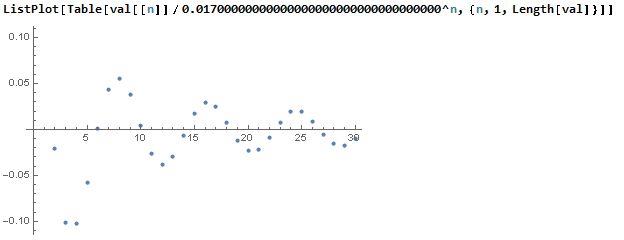Solving this problem analytically is difficult. However, it is possible to get exact values of the integral In in symbolic form for each n.
Integrate[(x^2*(1-x)*y^2*(1-y)/(1 + x^2*y^2))^n * Cos[(2*n+1)*ArcTan[x*y]]/Sqrt[1 + x^2*y^2]/.n->1, {x, 0, 1}, {y, 0, 1}]
(* -Catalan + (7 \[Pi])/8 - \[Pi]^2/16 - (7 Log[2])/4 *)
Integrate[(x^2*(1-x)*y^2*(1-y)/(1 + x^2*y^2))^n * Cos[(2*n+1)*ArcTan[x*y]]/Sqrt[1 + x^2*y^2]/.n->2, {x, 0, 1}, {y, 0, 1}] // Expand
(* 183/4 - 14 Catalan - (215 \[Pi])/24 + (5 \[Pi]^2)/12 - (77 Log[2])/6 *)
Integrate[(x^2*(1-x)*y^2*(1-y)/(1 + x^2*y^2))^n * Cos[(2*n+1)*ArcTan[x*y]]/Sqrt[1 + x^2*y^2]/.n->3, {x, 0, 1}, {y, 0, 1}] // Expand
(* -(19817/60) + 251 Catalan - (2927 \[Pi])/240 + (7 \[Pi]^2)/16 + (23263 Log[2])/120 *)
Such expressions can be obtained for any n, although for larger n it is time consuming.
val = Table[PrintTemporary[n]; Integrate[(x^2*(1-x)*y^2*(1-y)/(1 + x^2*y^2))^n * Cos[(2*n+1) * ArcTan[x*y]]/Sqrt[1 + x^2*y^2], {x, 0, 1}, {y, 0, 1}], {n, 1, 30}] // Simplify
The numerical values are as follows. To add to this, I want to note that using NIntegrate directly leads to error messages for larger n and I didn't have the patience to experiment with different parameters.
N[val,80]
(*
{0.0030701366658608634428975453931124728091424020885493502245540460203846958760120243,
-6.1569550293516657371596971272056926107472850125261746835292024037224512690511116*10^-6,
-4.9573022175486282585575903013967374515098952666994856787282182478234213973647599*10^-7,
-8.5871437907848650515391861076818180834313731950437975833725264035944670144903503*10^-9,
-8.2142613428795714287988511790242728239919040649430859172613586937930470981678207*10^-11,
1.3847044937167217659296663716706036001611975173651185822939781255019231276009811*10^-14,
1.7892711527483957052283014626334519856293879722336760989258099932899062104608207*10^-14,
3.8791957450524600173559499447778556429519581856113982851227359366936649427375936*10^-16,
4.4688571870968641320765463778878683437005599116429526971429151154358579120972046*10^-18,
8.3914481409477945438635344664629732959305998561577003644293574597060624394066275*10^-21,
-8.8842543487659752620985127585283776322638503832978387121964432909803043947819284*10^-22,
-2.2290195466141809766398229643702338390952818432313565865626406605990221043109963*10^-23,
-2.8983596441944885187441110949288862623074934486867401780613159046323596287604000*10^-25,
-1.0673137173487623000052380055834484778466784813621684416239454595648813068896001*10^-27,
4.9006181350152860567285197769086010465930052551654212673223247677394737465405394*10^-29,
1.4132103240916322425538872528472675573780649372052167023402247594655330128862634*10^-30,
2.0299922968246319562700270872831819565809052640092620068950499565550618199971013*10^-32,
1.0714203393584658262026710589507429970849323052551850498820947807378893482387450*10^-34,
-2.8044769253431543286543633334807384981760786222564720235651555740854098503653913*10^-36,
-9.4249586240745017219079387181752435641221544903175439338869668772753997907515923*10^-38,
-1.4810457081865403694515877019984012183433706845338026319683004142022100468049472*10^-39,
-9.9447329589238538069328666737557393046528488632778909386241092885628838297836445*10^-42,
1.6006426807866253855268101926575800966972719359475211857554988048656892969265927*10^-43,
6.4660883377643630555372355872487779640521658948433098252689782981852945262890840*10^-45,
1.1065363131572522311341783258591031212125083232318385492269815642245960609566333*10^-46,
8.8910007141678446811617375861730741584245887596260006038714285361964366761591463*10^-49,
-8.7618481707892914117384800850822389947781885829734616101664622703838618438789519*10^-51,
-4.5060965601973851295504650297384592444283858749128591326562530173333338764852701*10^-52,
-8.3869959324995378766606753663225941713348751399167746330285724111916441670602139*10^-54,
-7.7770904821425894968307520711548913135922351319128695952114560085955580373479135*10^-56}
*)
It is clear from these values that In -> 0, as n -> oo
But the following graphs are interesting:

From here it seems that Abs[In]^(1/n) converges somewhere towards 0.016..., which is supported by other graphs








ArcTan[xy]notArcTan[x y]. It's treating xy as a unique symbol instead of the product x*y $\endgroup$